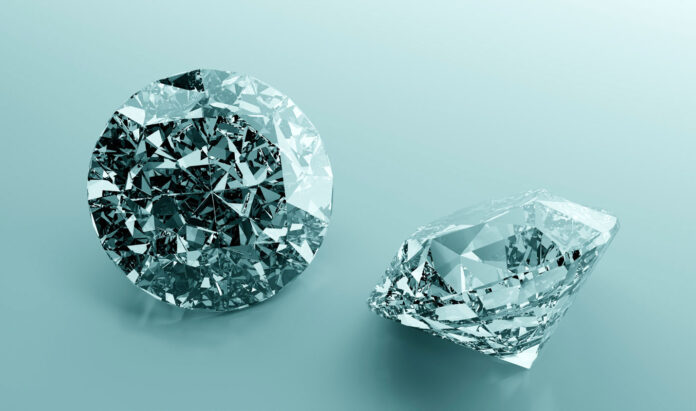I’ll be honest – this topic started out of pure curiosity. Everywhere I looked, people were talking about lab-grown diamonds. Friends were buying them, influencers were flaunting them, and jewelry brands were suddenly using words like “ethical,” “sustainable,” and “accessible.” But I couldn’t help wondering: Are lab-grown diamonds actually acceptable for major gifts? Or are they just for fun jewelry – like trendy heart necklaces and stackable rings?
I wasn’t sure. So, I turned to my Instagram community to get the real pulse – the unfiltered opinions. But before we dive into what everyone had to say, let’s clear up one thing:
What’s the difference between lab and natural diamonds?
At first glance, you’d never know the difference. Both sparkle. Both test as diamonds. Both can have the same cut, clarity, and brilliance. The main difference? Where they’re born.
Natural diamonds form deep in the earth over many millennium – under intense heat and pressure. Lab-grown diamonds, on the other hand, are created in controlled environments that mimic those same natural conditions.
Chemically, optically, and physically, lab diamonds are real diamonds. The difference lies in their origin – one mined from the ground, one grown in a lab. But that small distinction stirs up intense feelings, especially when it comes to symbolism, value, and what we call “real.”
Now that we’ve got that straight, let’s get into what the community had to say – and trust me, opinions were sparkling.
“They’re fake. No value.” – MD
MD didn’t hold back:
“To me, they’re fake. People are definitely buying them as engagement rings because they can get a big stone for very little money – but there’s no value in them. They’re cheap.”
“Our standards have changed.” – HL
HL took the conversation a step deeper – not just about lab vs. natural, but how the meaning of jewelry has evolved in general:
“I feel like this could be a continuation of your last article about weddings. The standards of our community are so high. Back in the day, an eternity band was a big deal – usually for a tenth anniversary. Today, we’re seeing very young women getting large eternity bands for their first anniversary or even as a baby gift.
“A tennis bracelet or necklace used to be a statement – something only a few women had. Now, everyone’s wearing one to carpool. When diamonds become everyday wear, it’s easy to justify going lab-grown for affordability.
“Personally, I think engagement rings should still be natural, no matter the size. There’s just something unmatched about a natural diamond. But when the norm is to be ‘dripping’ daily, I get why people turn to lab-grown. The only thing that bothers me is how overexposed diamonds have become – it’s like the exclusivity and quiet luxury are getting lost.”
“They are diamonds.” – Chana Kairy, Founder of Diamond Lab
Then there’s the business side – and no one knows that better than Chana Kairy, whose company was built on the belief that lab-grown diamonds are the real deal:
“My whole business was founded on the fact that lab-grown diamonds are absolutely diamonds. They’re just formed in a lab instead of in the earth. They’re chemically and optically identical to natural diamonds.
“Since we buy diamonds to wear them – not as investments – resale value shouldn’t matter. The natural diamond market was controlled by De Beers, who gave them their value by calling them rare and making them seem scarce. That’s what drove up the prices.”
“Fun, trendy, and guilt-free.” – RP
“Love them for trendy, fun pieces! I think it’ll take time for them to be acceptable as engagement rings though.”
“They make diamonds accessible.” – SK
“I love my lab-grown diamond heart necklace! It was a recent gift. I do feel like lab diamonds make otherwise high ticket jewelry more accessible since they’re so much more affordable. But I also wonder if, over time, real diamonds might lose some of their lust and genuineness if the market becomes flooded with lab-grown ones – especially since most people can’t tell the difference.”
“The future is already here.” – Isaac Douek, Founder of Clarté NYC
Industry insiders like Isaac Douek have seen the shift firsthand:
“After seven years in the jewelry industry, I’ve watched the world of diamonds change right before my eyes. What used to be unthinkable – lab-grown diamonds – have now become the heartbeat of modern luxury.
“Today, retail stores are selling 80 percent lab-grown diamonds. That says everything. At Clarté NYC, we embraced that shift early – not because it was trendy, but because it felt right. Lab-grown diamonds let us create pieces with the same fire, brilliance, and emotion – but with a sense of clarity, honesty, and purpose that aligns with the next generation. The future isn’t coming – it’s already here, and it’s glowing brighter than ever.”
“I’d rather have CZ.” – PA
Of course, not everyone’s convinced:
“I don’t understand the hype. Eventually it’s going to die down. Definitely not an investment for an engagement ring or wedding band. Personally, I’d rather cubic zirconia – at least it’s cheap! I think lab diamonds are a hot trend that’ll fade. I don’t own any lab-grown pieces. It’s just not appealing to me – and I love jewelry! I’d rather wear costume jewelry.”
“They’re great – but not the same.” – SM
“I think they’re a great option for people who want the diamond look but don’t have the budget for a natural one and don’t want to buy something fake.
“Do I think they’re a valid substitution? Not really. Lab diamonds don’t hold their value like natural diamonds. As technology advances, there’ll be more and more lab-grown diamonds on the market, which will make them even cheaper. Natural diamonds are harder to come by, so they’ll always hold a certain prestige.
“For engagement rings, it really depends on the person. With the same budget, you can get a smaller natural diamond or a bigger lab-grown one. So it really comes down to what the girl prefers – bigger sparkle or natural origin?”
“It’s personal – I’m warming up to them.” – SS
SS described her evolving perspective:
“It’s definitely a personal preference. If you put it on and feel good about it, that’s what matters. Real? Yes. Natural? No – it’s man-made. In my opinion, lab-grown studs are fine, but not for an engagement ring.
“I was very against lab-grown for a long time, but they’ve evolved. They look great now. I still prefer all my jewelry to be natural, but I’m getting more comfortable with lab-grown. Especially for bigger eternity bands – it just makes sense.”
“I wanted bigger, and I love it.” – RK
“I had two options – a smaller natural diamond or a bigger lab-grown one. In the past, people worried about passing down their engagement rings or being able to sell them one day. That’s not my concern. I wanted a ring I’d love for as long as I wore it.
“I wanted bigger. I wanted blingier. And to afford that, it meant lab-grown for me. I get compliments all the time – no one asks if it’s lab-grown, and I don’t offer that detail. Why spend more for something I don’t love as much? It’s not selfish to choose what makes you happy.”
So… are lab-grown diamonds “invest or bust”?
After hearing all sides, it’s clear there’s no single answer.
If you see jewelry as an investment or as a legacy piece to pass down, natural diamonds still hold that symbolic (and financial) weight. They’re rare, timeless, and carry history in their sparkle.
But if you wear jewelry for you – for the joy, the look, the fashion – lab-grown diamonds make luxury more inclusive. They’re just as beautiful, conflict-free, and allow you to play bigger without the price tag.
And maybe that’s the real takeaway: the value of a diamond isn’t just in its origin – it’s in the feeling it gives you when you put it on.
For some, that means a mined diamond with all its heritage. For others, it’s a lab-grown stone that shines just as bright – maybe even brighter – knowing it came without compromise.
Like it or not, lab-grown diamonds are here to stay. The sparkle isn’t fading – it’s just evolving.
Frieda is an event and portrait photographer. Check Frieda out on Instagram @friedaschwekyphoto For photography inquiries or article topic suggestions email her at friedaschweky@gmail.com.



